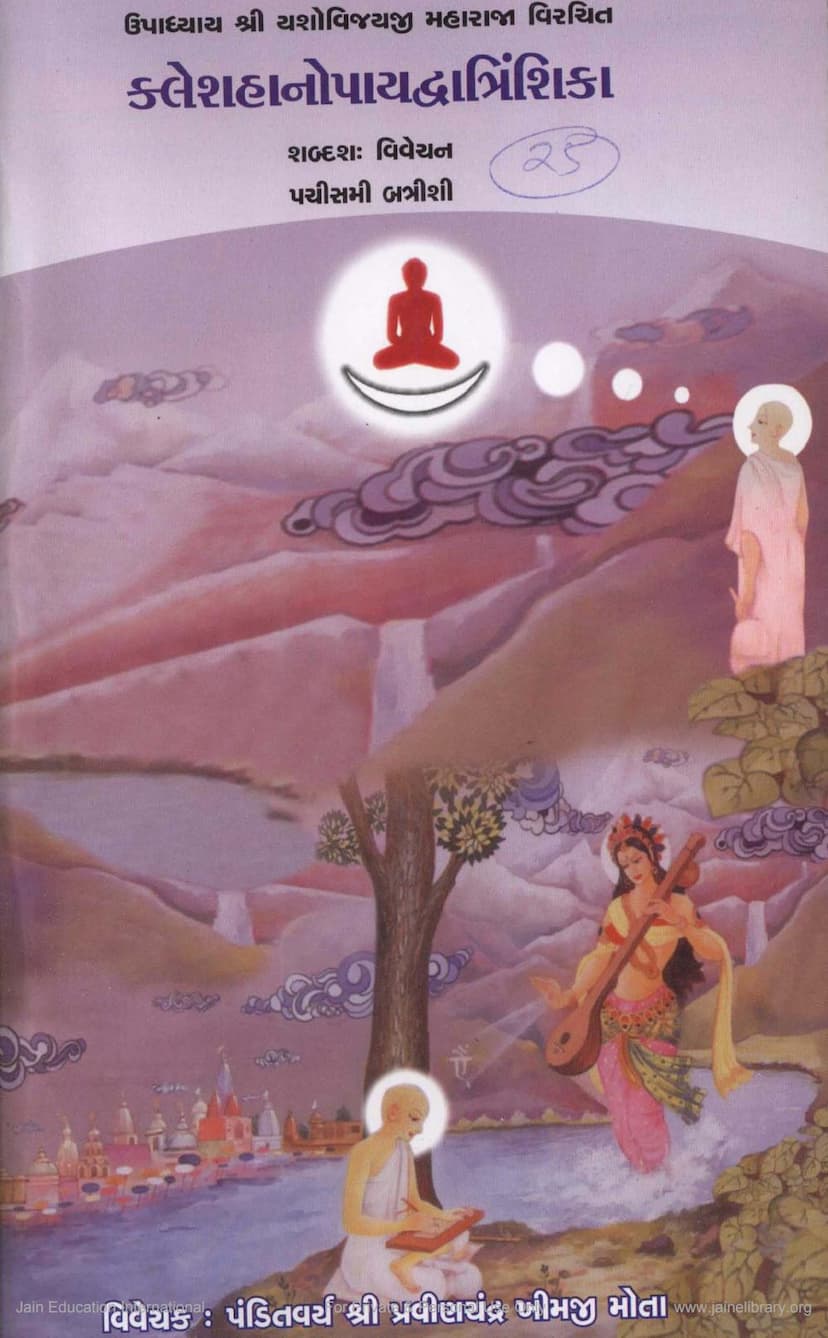Kleshhanopay Dvantrinshika
Added to library: September 2, 2025

Summary
Here is a comprehensive summary in English of the Jain text "Kleshhanopay Dvantrinshika," based on the provided pages:
Book Title: Kleshhanopay Dvantrinshika (ક્લેશતાનોપાયદ્વાચિંશિકા) Author: Acharya Yashovijayji (ઉપાધ્યાય શ્રી યશોવિજયજી મહારાજા) Commentary/Analysis By: Pandit Pravinchandra Himji Mota (પંડિતવર્ય શ્રી પ્રવીણચંદ્ર ખીમજી મોતા) Publisher: Gitarth Ganga (ગીતાર્થ ગંગા)
Overview:
The text "Kleshhanopay Dvantrinshika" is the 25th chapter (or "batrishi" - a set of 32 verses) within the larger work "Dvatrimshat-Dvatrimshika" (द्वात्रिंशद्वात्रिंशिका) by the esteemed Jain scholar Acharya Yashovijayji. This specific chapter focuses on the "Means to Vanquish Afflictions" (Kleshas). The book presents a detailed word-by-word analysis (શબ્દશઃ વિવેચન) of Acharya Yashovijayji's original verses, along with its philosophical context and critique of other philosophical schools' perspectives on overcoming afflictions.
Key Themes and Content:
-
Context within Dvatrimshat-Dvatrimshika: The "Kleshhanopay Dvantrinshika" follows the "Saddrishti Dvantrinshika" (24th chapter), which discussed "Right Views." The author, Acharya Yashovijayji, clarifies that these "Right Views" (Saddrishti) become effective means for overcoming afflictions (Kleshas) only when they are combined with true knowledge (Samyak Jnana) and right conduct/action (Samyak Anushthan). Therefore, this chapter delves into the specific means for vanquishing these afflictions.
-
The Nature of Kleshas: The text identifies Kleshas as the elements that obstruct the soul's journey towards liberation (Moksha). While different philosophical schools may use various terms like Karma, Avidya (ignorance), Adrushta, or Paasha, the core concept remains the same: these are the causes of suffering and entanglement in the cycle of birth and death (Samsara). Acharya Yashovijayji uses the term "Klesha" to denote these primary causes of suffering.
-
Critique of Other Philosophical Schools: A significant portion of the text involves a detailed analysis and critique of how other major Indian philosophical systems propose to overcome Kleshas. This includes:
- Jainism: The text establishes the Jain perspective that the means to overcome Kleshas are Samyak Jnana (right knowledge) and Samyak Kriya (right action). This involves understanding the true nature of reality as taught by the Jinas and acting in accordance with that knowledge to destroy Karma.
- Buddhism: The Buddhist view of overcoming Kleshas through Nairatmya Darshan (the view of non-self or the impermanence of the self) is presented and critically examined. The author argues that the Buddhist concept of "no-self" is logically flawed and does not provide a sustainable basis for liberation or for the practice of the spiritual path.
- Patanjali Yoga: The Yoga school's concept of Vivek-Khyati (discriminative discernment between Purusha and Prakriti) as the means to overcome Kleshas is discussed. The author analyzes the stages of attainment in Yoga (seven states of refined wisdom) but also points out inconsistencies, particularly regarding the nature of the liberated Purusha.
- Nyaya: The Nyaya school's idea that overcoming Kleshas is achieved through actions that lead to the ultimate cessation of suffering (Charam-Duhkha) is presented and refuted. The author questions the logic of pursuing suffering to eliminate suffering, especially when Moksha is also seen by Nyaya as merely the absence of suffering, not necessarily bliss.
- Other Schools: The text also briefly addresses other philosophical viewpoints to further establish the superiority of the Jain approach.
-
The Jain Path to Klesha-Nasha (Vanquishing Afflictions):
- The core argument reinforced throughout the book is that Kleshas are essentially forms of Karma (especially the four Ghati Karmas – knowledge-obscuring, perception-obscuring, deluding, and energy-obscuring).
- The destruction of these Kleshas (and thus Karma) is achieved through Samyak Jnana (right knowledge, obtained through the teachings of the Jinas) and Samyak Kriya (right action, encompassing the principles of Jain ethics and spiritual practices).
- This path involves diligent effort, practice of virtues, and the cultivation of right understanding, which purifies the soul and ultimately leads to the annihilation of Karma and the attainment of liberation (Moksha).
-
Detailed Analysis of Kleshas (according to Yoga as interpreted by the commentator): The commentary by Pandit Mota meticulously breaks down the nature of Kleshas as understood in the context of Yoga, elaborating on their various states:
- Kleshas are classified as: Avidya (ignorance), Asmita (egoism), Raga (attachment/desire), Dwesha (aversion/hatred), and Abhinivesha (clinging to life/fear of death).
- States of Kleshas: Each of these Kleshas can exist in four states:
- Prasupta (dormant): Hidden, not manifesting, like a sleeping child's afflictions.
- Tanu (attenuated): Weakened, but still capable of manifesting under specific strong conditions, like a yogi's afflictions requiring significant effort to overcome.
- Vicchinnna (intermittent): Manifesting periodically, interrupted by the influence of opposing Kleshas (e.g., Raga manifesting when Dwesha is not dominant).
- Udar (manifest/intense): Fully active and potent, influencing thought and action.
- The Role of Avidya: Avidya is considered the root cause and the "field" (Kshetra) for the other Kleshas. When Avidya is destroyed through Vivek-Khyati (discriminative knowledge), the other Kleshas are also uprooted.
-
The Ultimate Goal: The ultimate aim of this spiritual journey, as per Jain philosophy, is Moksha – a state of pure, blissful, and eternal existence, free from all forms of suffering and the cycle of rebirth. The text concludes that the rigorous path of Samyak Jnana and Samyak Kriya (Yoga in a broad sense) is the means to achieve this ultimate state.
Publisher's Note: The publication is a result of the efforts of the "Gitarth Ganga" trust, aiming to bring forth the profound meanings within the scriptures of great acharyas like Acharya Yashovijayji. It highlights the contribution of scholars and disciples in making these profound texts accessible to the Jain community.
In essence, the "Kleshhanopay Dvantrinshika" provides a critical and detailed exposition of the Jain path to liberation by analyzing the nature of afflictions, refuting the methodologies proposed by other philosophical schools, and ultimately reaffirming the efficacy of right knowledge and right conduct as the supreme means to overcome all Kleshas and achieve the ultimate goal.